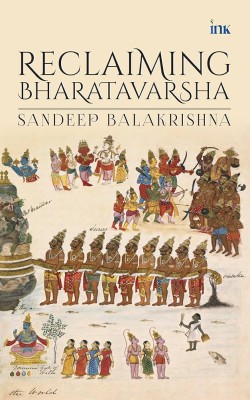Formulas and Techniques for Preparing Hair Dyes in Ancient India

Image credit BluOne Ink
Book Excerpt: Reclaiming Bharatavarsha by Sandeep Balakrishna
Sandeep Balakrishna is a historian with nose for deep research. His latest book ‘Reclaiming Bharatavarsha’ delves deeper into the ancient texts while also exploring changes across centuries.
Reclaiming Bharatavarsha has three broad themes – classical Bharatavarsha, conditions of India under colonial rules, and imprints of foreign rule on contemporary national life. Balakrishna is sharp in his analysis with the moral compass firmly rooted in the glory of the ancient India.
Balakrishna advocates shunning western universalism. He backdrops the ‘Woke Epidemic’ to the Telugu blockbuster Jamba Lakidi Pamba in which a “Sadhu foretells how society will hurtle into utter degeneration and collapse in five phases”.
An excerpt from Reclaiming Bharatavarsha
One of the earliest treatises that gives detailed recipes for preparing hair dyes is a delightful Sanskrit work titled Nāvanītakaṃ. Dating back to the 2nd century ce, the work is primarily an Ayurvedic compendium that also deals with a number of allied subjects.
Verses 1 through 27 in the tenth chapter of the Nāvanītakaṃ deal with the recipes for preparing hair dyes. What strikes us instantly is the intimate, detailed, and expert knowledge of a stunning range of plants, herbs, (organic) chemicals, and metals used for making hair dyes.
Also Read: ‘The Collector’s Mother’ traces journey from extreme poverty to IAS
Even more astounding is the manner in which it provides precise information for making a variety of concoctions and mixtures to produce specific results. A further nuance is also interesting to note: not all ingredients were used directly as hair dyes; some were used merely as dye-producing agents.
However, the ultimate goal was the same: to produce deep black or blue-black hair dyes. Like all traditional treatises or compendia related to worldly knowledge that were produced in India in ancient times, the Nāvanītakaṃ too invokes various Devatas and proclaims that using the hair-dye signals maṅgalam or auspiciousness, and that it aids in the attainment of the puruṣārthas.
The original Sanskrit term for hair dye is keśa-rāga (literally, ‘hair colour’). This is also the title of the tenth chapter of the Nāvanītakaṃ.
Also Read: Book on Vijay Raman, Pan Singh Tomar encounter fame, unveiled
Unfortunately, the full text of the work is not available, and in many places, words, entire sentences, and even whole chapters of the original manuscript are unavailable.
The following were some of the recipes for preparing hair dyes in ancient India.
- Boil (text missing) and oleander in sesame oil. This mixture, applied as nasal drops or an ointment, is an approved remedy for turning grey hair black.
- A paste made of prapauṇḍarika (a variety of ginger) (text missing) and applied as a plaster, is a remedy for turning grey hair black.
- Bamboo-manna, garden-nightshade, śatapuṣpa (Peucedanum graveolens), and sesame seeds, when applied to the hair, cause it to become as black as antimony. Antimony is also used in the preparation of Kohl.
- Indigo, rock salt, and long pepper, mixed with water and ground into a paste when applied to the hair, cause it to turn black.
- First, wash the head with chebulic and emblic myrobalans. Then prepare a paste of alambuṣā (Sphaerantus indicus) and indigo, and with it, while warm, anoint the head and leave it on for some time. The hair will not turn grey.
- Collect the following: copper sulphate, Musta (Cyperus rotundus), iron sulphate, bile of a turtle, powdered iron, danti (Baliospermum montanum), Sahadeva (Sida rhomboidea), and Bhṛṅgarāja.
Take one part of each, boiled with the oil of beleric myrobalan. This is a remedy for turning grey hair black, and if it is applied regularly as an ointment, it will prevent the hair from turning grey.
Also Read: Krishna Niti timeless strategic wisdom decodes sagely messages
- One prastha (about 10 kg) of the juice of bhṛṅgarāja, the same quantity of milk, and one pala (about 11 grams) of liquorice, boiled in one Kudava (about 186 grams) of oil, will make even a crane turn black.
Within a week, it will remove wrinkles and grey hair for 12 years. Within a month, it will do the same for one hundred years if administered as nasal drops.
- Take two pala of the roots of rāmataruṇi (Rosa alba), one pala of liquorice, half a pala of savaraka (Symplocos racemosa), and 10 pala of the oil of beleric myrobalan. Boil it in the heat of the sun in an iron vessel for 10 days, and administer it as nasal drops. This will make grey hairs become the same colour as the large black bee.
One prastha of the juice of emblic myrobalan, the same quantity of ghee, and one pala of liquorice—all this together—should be boiled over a gentle fire.
Also Read: Nastik Why I Am Not An Atheist lenses neo-atheism wildfire ex-Muslims rise
Its application as an ointment will give sight to the blind and black colour to grey hair. If it is continually administered as nasal drops, it will even restore a person’s lost sight.
- Take equal parts of no more than one emblic myrobalan from each of the three myrobalans, indigo, and blue lotus. Take also the fruit of piṇḍāraka (Vangueria spinosa), antimony sulphide, roots of long pepper, and leaves of sahacara (Barleria cristata), and add a decoction of Jamun and soil from the roots of the Jamun tree. Grey hair will turn black.
- Take the fruit of Kakubha (Terminalia arjuna) and two kudava of sesame oil, and boil the whole in the oil of beleric myrobalan slowly over a gentle fire. Administer it as nasal drops for 15 days.
On the 16th day, the noble patient will have left no white hair, his scalp will be black, his face and eyes will look shiny, and all his hair will be of a deep dark colour, says Agastya, the best of teachers.
- Take the three myrobalans, flowers of sahacara (Barleria cristata), Jamun, Kars’marya (Gmelina arborea), flowers of kakubha (Terminalia arjuna), kernel of the mango, and fruit of piṇḍāraka (Vangueria spiñosa), iron sulphate, flowers of āsana (Terminalia tomentosa), indigo, blue lotus, knots of the rootstalk of the lotus, antimony sulphide, black mould, powdered iron, two kaptakärika, two S’ariva, Madayanti (Jasminum Sambac), juice of Bhṛṅgarāja (Eclipta alba), and oil of beleric myrobalan.
Mix all this with a decoction of āsana (Terminalia tomentosa) and let it stand unboiled for 10 days in an iron vessel. After this, boil it thoroughly over a gentle fire, and add to it one half as much of shukta (fermented rice water).
Also Read: ‘Stalled Wheel Of Justice’ delves deep into systemic judicial stillness
This shukta should have already been kept in Mudga (Phaseolas mungo) and Māsha (Phaseolus roxburghii). Then, on the completion of the half month, having kept it well-protected in the meantime, administer this preparation.
Having prepared one’s body with the three myrobalans and dieting on Kichdi, one should use this oil as nasal drops in doses of one shukti (conch shell) at a time, with care and in a sheltered spot.
If a person who has a head full of white hair takes one prastha of this oil as nasal drops, his hair will turn black.
(The excerpt is published with permission from BluOne Ink, the publisher of Reclaiming Bharatavarsha)
Join WhatsApp channel of The Raisina Hills







